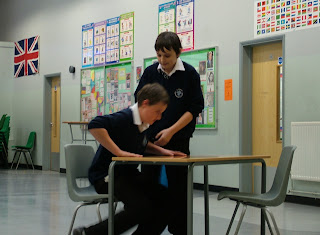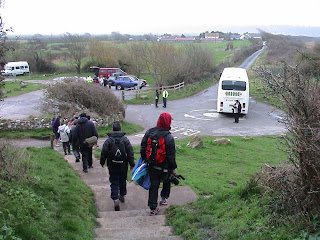Jackie and Jane worked with 28 year 9 students from Eastwood Comprehensive for an intensive day workshop on the DH Lawrence Blue Line trail, student responses, and how this could develop into locative media to augment the trail.
What a fantastic day, everyone worked really well together and tackled a big range of activities with some really creative results.
Thanks to Miss Hale, head of English, and Miss Lee, at the school on PGCE placement for the valuable preparatory work introducing the students to extracts of Lawrence's writing - in particular the kitchen argument scenes - set in the Breach House, where Lawrence lived from 2-6 years of age.
The day started with quick introductions and a recap of themes identified in the preparatory work: childhood, weather, arguments/aggression, mining/work, uncertainty/suspense, to which Strata added: identity, home.
Then we split into 2 groups to walk parts of the trail and visit in turn the Breach House and the Canyons (where Lawrence played as a child). At each location we asked the students to word-storm 3 words for each of the themes, stressing the importance of their individual response, as we'd return to these word-storms throughout the day.
On return to school, students paired up and were given one of the themes on which to create an improvised mini-drama, or cameo scene. Using their word-storm responses to each of the locations, they created an 'argument' which might reflect difference of opinion in the responses, difference between the locations, tensions in the theme, or reflections on the original texts. In just 15 minutes some great ideas evolved, and each pair then 'performed' their mini-drama to the rest of the class.
After a full and interesting morning, the afternoon activities tightly focused ideas and responses into paper-based form.
We discussed Lawrence's poem, Discord in Childhood (1916, from the collection Amores).
The 2 verses follow an ABAB ABBA pattern and contrast inside with outside, touching on other themes already identified.
Each pair then had just over half an hour to workshop their word-storm responses and the actions of their mini-dramas into an 8 line poem, drawing on elements of Discord in Childhood to inform the construction of their poem.
Not everyone completed 8 lines, but there were some fantastic original efforts to develop further in school over the coming weeks.
Meanwhile the next activity focused on the images in the poetry, asking each pair to storyboard their poem, a frame per line, as if to create a short illustrated film.
The considered approach behind this was that students would have started with an in-situ, embodied experience of the world through Lawrence's eyes, overlaying their own response to the locations as young people growing up in the area today. This would distill into a physical drama, creating action- images based on the words and themes of their response. Those actions would condense into words in the form of poetry, which could then easily expand again to consider the framing and imagery to accompany the text. Ideally the combination could then be recorded - participant voices with screenshot storyboard frames, as a series of young people's works based on two of the locations of the Blue Line trail. A natural flow from location through embodied reflection to creative output as text and image in time.
The final pair of activities were intended to demonstrate the way this creative work could augment the trail using locative media.
Jackie gave a quick introduction to gps-triggered locative media, the empedia website and the Blue Line Locative Media project development. The project is a partnership between DHLawrence Heritage, IOCT De Montfort University and Cuttlefish Multimedia, funded by MuBu. Paul from Cuttlefish, who was filming some of the activities and creative work for use on the project, explained how empedia will work, demonstrating QR codes as a trigger for media content, and dazzling us with the content coming to life on his ipad and iphone.
Students were quick to grasp the implications of the technology, and were then challenged in the final activity to think about the challenges of organising routes through the vast amount of data/content that could potentially be 'out there' in the virtual environment or online.
Seven coloured balls of wool represented the themes we had explored during the day. Two high tables represented the two locations, Breach House and Canyons.
Each student was asked to write down their word-storms relating to the theme they had focused on, a word per coloured paper, and to peg them onto the theme (wool) near the location described. 6 words = 6 sheets per person x 28 people = quite a lot of pegs!
Next, using coloured mini-post-its, everyone wrote down key words from their word-storms related to the other themes, and attached these to the growing cats-cradle of tags.
A visualisation of tagged data relating to two locations!
What I hadn't anticipated was that in doing this, 7 new poems had been collaboratively created, one per theme.
Students who had completed poems volunteered to read out their own pair's poem to the class, and then to read the new 'poem' created on that theme by the tags of paper.
Quite a lot of words repeated in the new poems, emphasising the importance of giving your own unique response rather than discussing and sharing word-storms amongst friends. It also emphasised how the students had responded in some similar and some contrasted ways to each theme. Surprisingly the second theme narrated had NO words in common with the first theme. The third theme, again very different in responses, had just one word in common - raising the example that text could be narrated not just in a linear way along the themes, but also across themes, offering more ways for 'users' to explore the 'content' or 'data' according to their own interests.
The final pair chose to recite their own poem with different voices for alternate lines, and reflected this in narrating the new collaborative theme 'poem' by reading tags from each location in turn, gradually moving in to reach the mid-point together. Lots more room for experimentation.... and a great way to visualise the technical context whilst returning to our starting point of the day - themes and word storms, collaboration and individuality.
Jane and I both felt what a pleasure it had been to work with such and engaged and inspiring group of young people and two fantastic members of staff - a real pleasure to go away tired but invigorated and wishing we had a couple more days to work up the material further with the students.
The staff have plans to develop the poetry and the storyboards further with in-school media support, so we look forward to hearing how the work evolves and hopefully to experiencing some of it on location when we next visit Eastwood to walk the trail, empedia app in hand!


























































